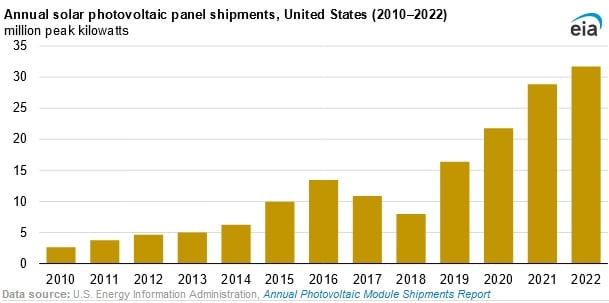U.S. Solar Panel Shipments Set a Record High During 2022: EIA

Solar panel shipments in the U.S. increased by 10 percent in 2022, compared to 2021 and set a record high of 31.7 million peak kilowatts (kWp), according to an Aug. 29 report from the U.S. Energy Information Administration. U.S. solar shipments consisting of imports, exports and domestically produced and shipped panels have risen, in line with growing solar capacity. Majority of the solar panel shipments during 2022 were imports from Asia and accounted for 88 percent of the total trade.
Some new projects that developers originally planned for 2022 were canceled or delayed until 2023 due to supply chain issues including detaining solar panels at the U.S. border. The U.S. Customs and Border Protection released modules that were detained as part of its implementation of the Uyghur Forced Labor Prevention Act, a U.S. regulation that restricts imports associated with China’s Xinjiang district unless the importer can verify that equipment were made without the use of forced labour. Customs released detained panels after importers proved their compliance, but the delay affected the timelines for some new projects.
The increase in imports can also be attributed to President Joe Biden waiving tariffs on certain photovoltaic cells and modules from Southeast Asia and favourable tax incentives in the 2022 Inflation Reduction Act, which have promoted domestic solar facilities.
U.S. solar capacity has risen significantly since 2010, which incorporates both utility scale solar farms and small scale solar. The agency’s Annual Electric Generator Report finds that the U.S. added 10.9 gigawatts (GW) of new utility scale solar capacity in 2022, the second largest annual addition, following a record set in 2021 of 13.5 GW. Moreover, in 2022 the U.S. added 6.4 GW of new small scale solar capacity, a record high and 0.9 GW higher than 2021.
The rise in small scale solar can be attributed to increasing demand for residential rooftop solar installations. The increase in solar capacity was prominent in the state of Florida, with the largest power utility in the state, Florida Power and Light adding almost 80 percent of solar capacity increased in the state.
In terms of costing, solar panel expenditures have declined since 2010 and this has been a key driver of solar capacity growth in the U.S. Estimates suggest that the average value of U.S. solar panel shipments declined from $1.96/kWp in 2010 to $0.39/kWp in 2022.
The increase in U.S. solar panel shipments is expected to continue into 2023. During the first half of 2023, developers added 16.8 GW of new electricity generating capacity to the U.S. electricity grid, according to the agency. Solar power represented the largest share of the new power generating capacity at 35 percent. As it stands, developers intend to add an additional 35.2 GW of power generating capability in the second half of the year. Majority of the planned capacity is projected to be from solar (19.3 GW).
EnerKnol Pulses like this one are powered by the EnerKnol Platform—the first comprehensive database for real-time energy policy tracking. Sign up for a free trial below for access to key regulatory data and deep industry insights across the energy spectrum.
ACCESS FREE TRIAL